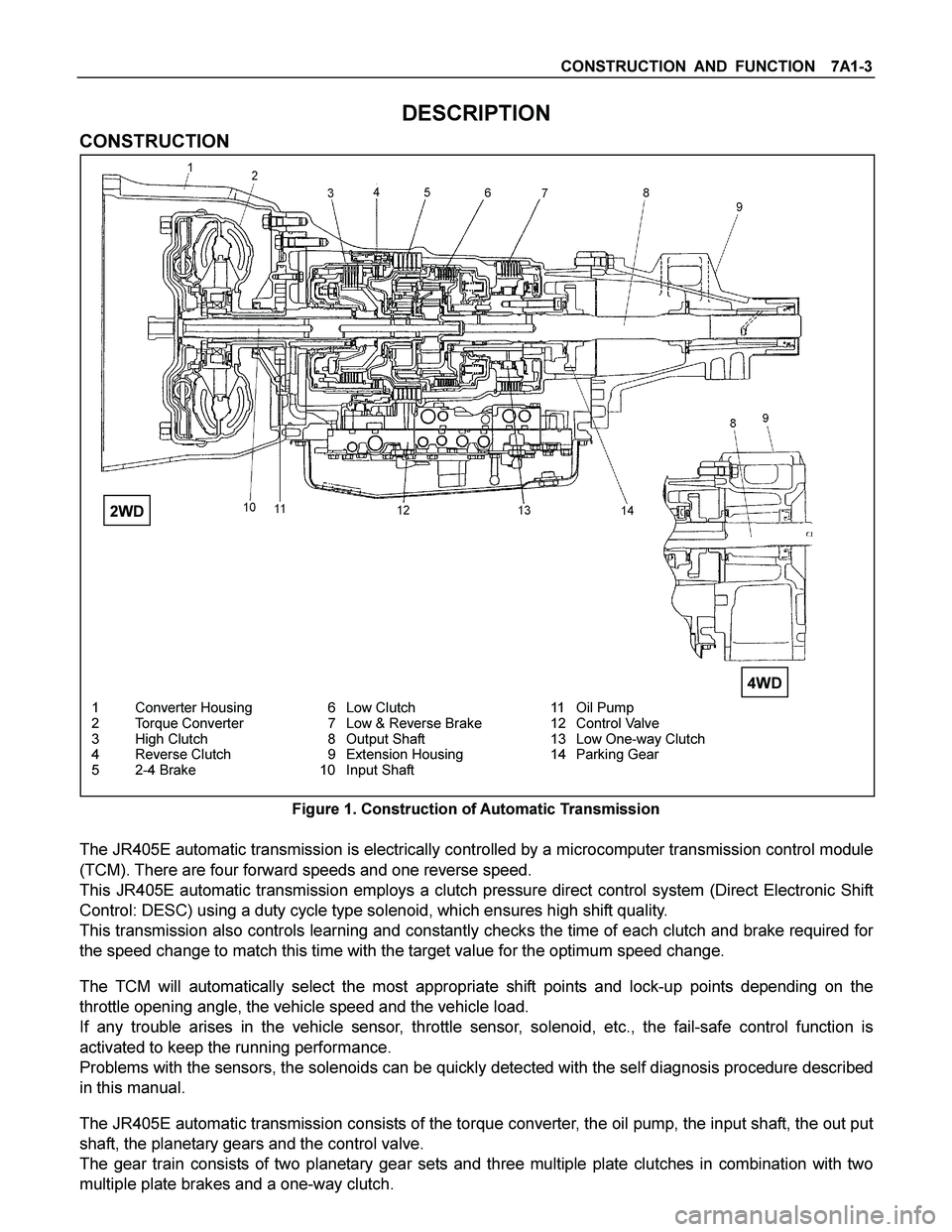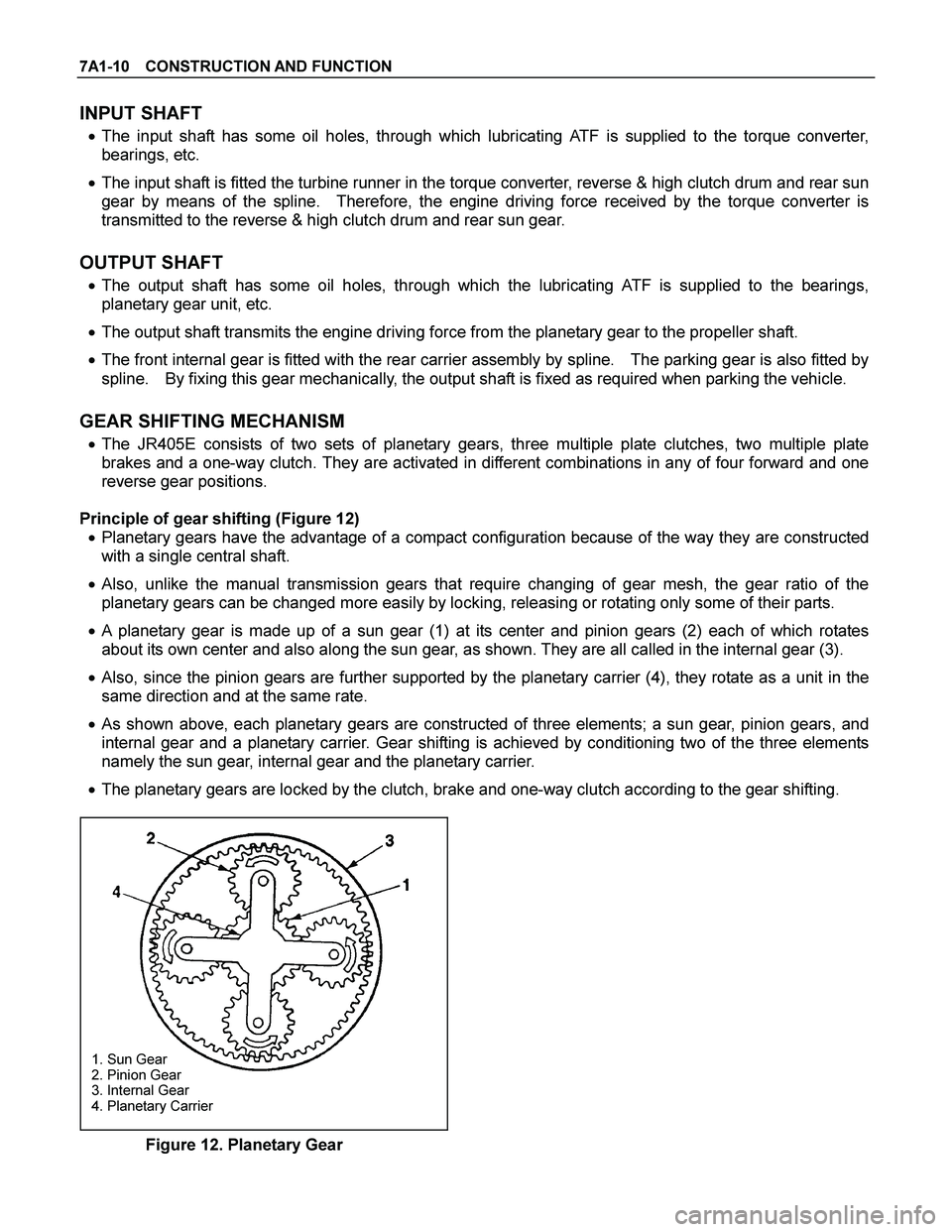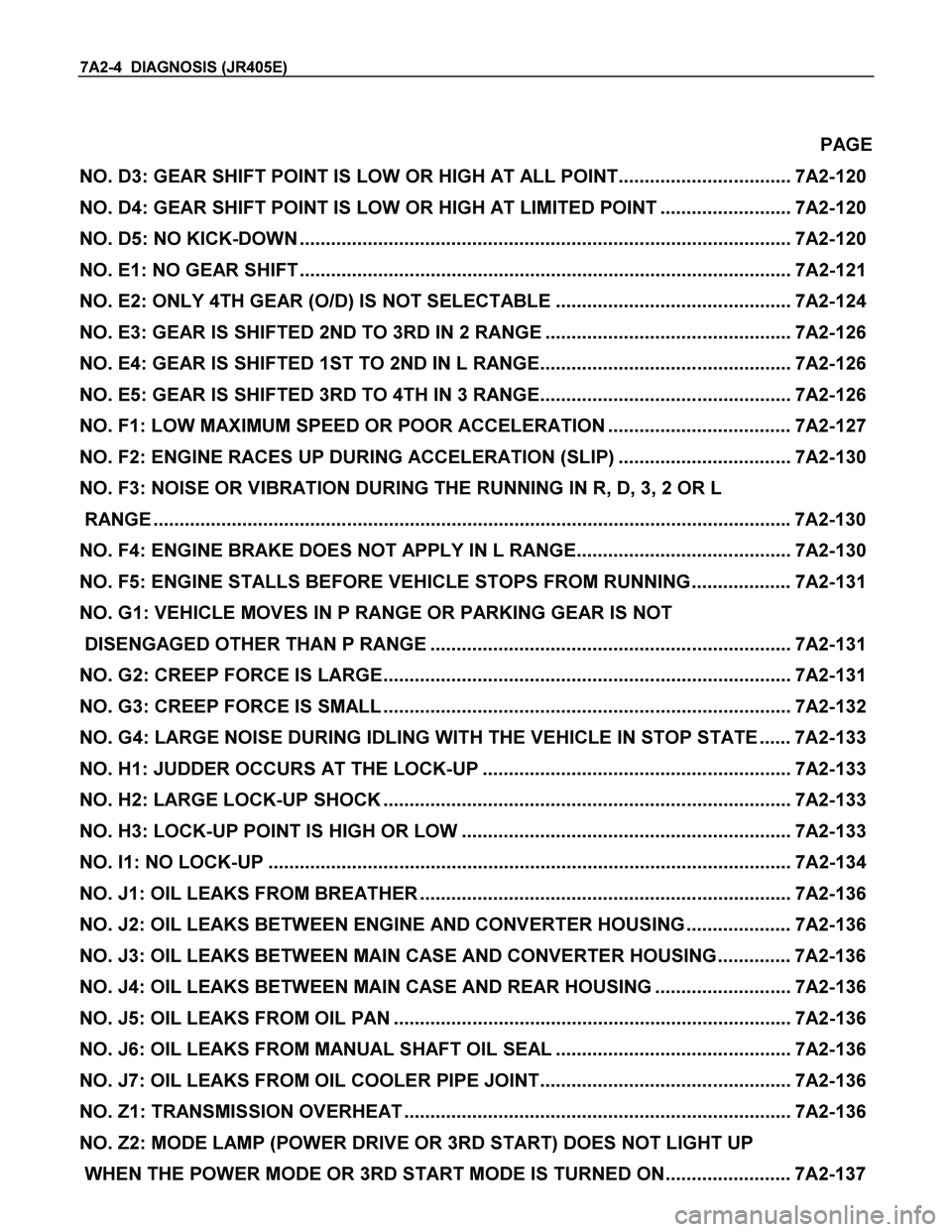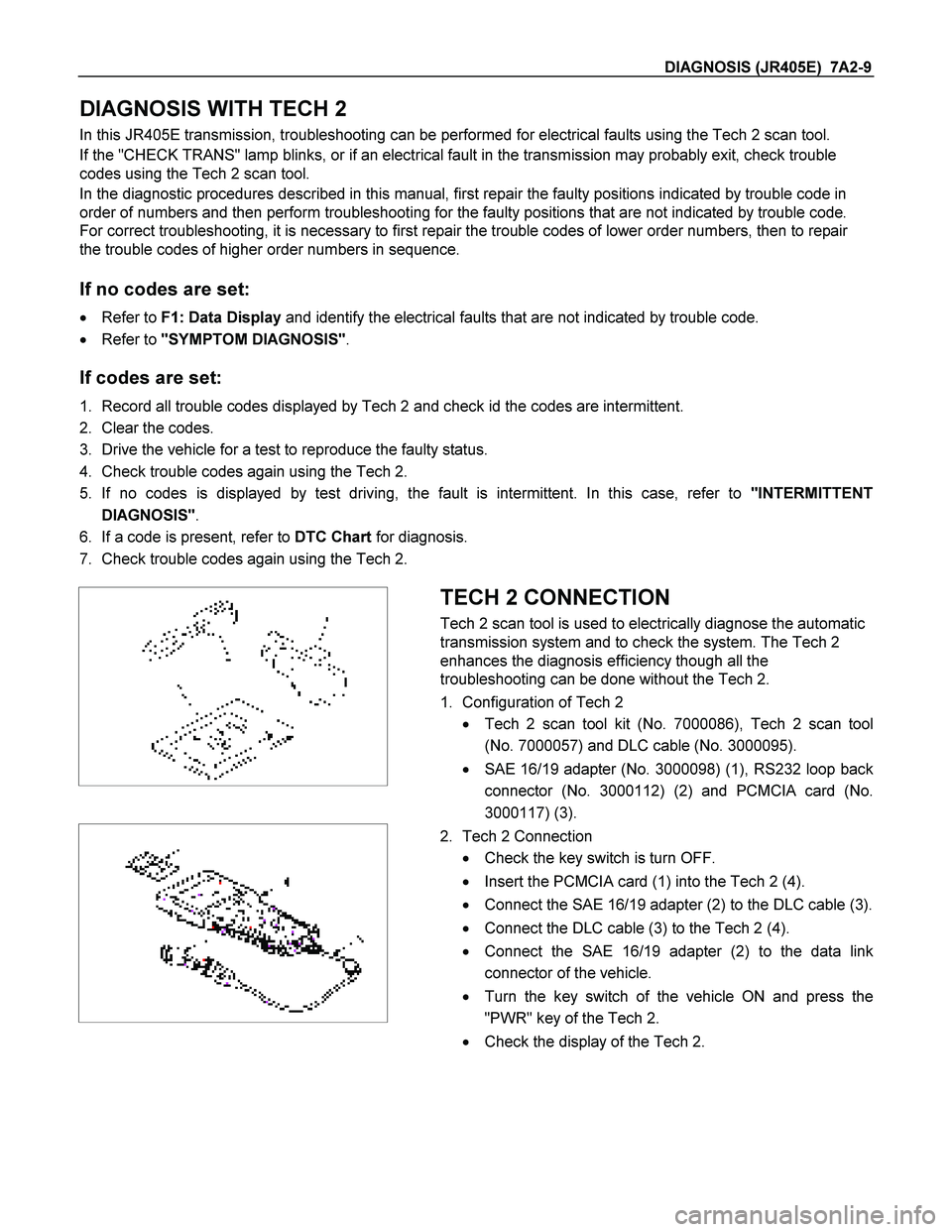Page 3900 of 4264
7A4–92 UNIT REPAIR (AW30–40LE)
Transmission Valve Body assembly
Disassembled View
2 40R20 0039
E nd O FCallo ut
Legend
(1) Detent spring
(2) Manual shift valve
(3) Upper valve body
(4) No.1 gasket (Upper valve body side)(5) Valve body plate
(6) Clamp
(7) Pressure control solenoid
(8) No.2 gasket (Lower valve body side)
(9) Lower valve body
Page 3929 of 4264
UNIT REPAIR (AW30–40LE) 7A4–121
Transmission Case
Disassembled View
24 9RY 0 0001
E nd O FCallo ut
Disassembly
1. Using a chisel, cut off the spacer and remove it from
the shaft.
24 9RY 0 0002
Legend
(1) Spacer
(2) Pin
(3) Manual valve lever shaft(4) Manual valve lever
(5) Oil seal
(6) Oil seal
Page 3930 of 4264
7A4–122 UNIT REPAIR (AW30–40LE)
2. Using a punch, drive out the pin.
24 9RY 0 000 3
3. Pull the manual valve lever shaft out through the
case by the threads.
4. Take out the manual valve lever.
5. Using a screwdriver, remove the oil seals.
24 9RY 0 000 4
Reassembly
1. Coat a new oil seal lip with multi purpose grease.
Using special tool, drive in the oil seal.
Oil seal installer : J–37232–2
RTW3 7A SH00 0701
2. Assemble a new spacer to the manual valve lever.
3. Install the manual valve lever shaft to the
transmission case through the manual valve lever
by the threads.
24 9RY 0 0005
Page 3945 of 4264
WORKSHOP MANUAL
TF SERIES
TRANSMISSION
JR405E MODEL
SECTION 7A
Page 3949 of 4264

CONSTRUCTION AND FUNCTION 7A1-3
DESCRIPTION
CONSTRUCTION
1 Converter Housing 6 Low Clutch 11 Oil Pump
2 Torque Converter 7 Low & Reverse Brake 12 Control Valve
3 High Clutch 8 Output Shaft 13 Low One-way Clutch
4 Reverse Clutch 9 Extension Housing 14 Parking Gear
5 2-4 Brake 10 Input Shaft
Figure 1. Construction of Automatic Transmission
The JR405E automatic transmission is electrically controlled by a microcomputer transmission control module
(TCM). There are four forward speeds and one reverse speed.
This JR405E automatic transmission employs a clutch pressure direct control system (Direct Electronic Shift
Control: DESC) using a duty cycle type solenoid, which ensures high shift quality.
This transmission also controls learning and constantly checks the time of each clutch and brake required for
the speed change to match this time with the target value for the optimum speed change.
The TCM will automatically select the most appropriate shift points and lock-up points depending on the
throttle opening angle, the vehicle speed and the vehicle load.
If any trouble arises in the vehicle sensor, throttle sensor, solenoid, etc., the fail-safe control function is
activated to keep the running performance.
Problems with the sensors, the solenoids can be quickly detected with the self diagnosis procedure described
in this manual.
The JR405E automatic transmission consists of the torque converter, the oil pump, the input shaft, the out put
shaft, the planetary gears and the control valve.
The gear train consists of two planetary gear sets and three multiple plate clutches in combination with two
multiple plate brakes and a one-way clutch.
2WD
4WD
Page 3956 of 4264

7A1-10 CONSTRUCTION AND FUNCTION
INPUT SHAFT
� The input shaft has some oil holes, through which lubricating ATF is supplied to the torque converter,
bearings, etc.
� The input shaft is fitted the turbine runner in the torque converter, reverse & high clutch drum and rear sun
gear by means of the spline. Therefore, the engine driving force received by the torque converter is
transmitted to the reverse & high clutch drum and rear sun gear.
OUTPUT SHAFT
� The output shaft has some oil holes, through which the lubricating ATF is supplied to the bearings,
planetary gear unit, etc.
� The output shaft transmits the engine driving force from the planetary gear to the propeller shaft.
� The front internal gear is fitted with the rear carrier assembly by spline. The parking gear is also fitted by
spline. By fixing this gear mechanically, the output shaft is fixed as required when parking the vehicle.
GEAR SHIFTING MECHANISM
� The JR405E consists of two sets of planetary gears, three multiple plate clutches, two multiple plate
brakes and a one-way clutch. They are activated in different combinations in any of four forward and one
reverse gear positions.
Principle of gear shifting (Figure 12)
� Planetary gears have the advantage of a compact configuration because of the way they are constructed
with a single central shaft.
� Also, unlike the manual transmission gears that require changing of gear mesh, the gear ratio of the
planetary gears can be changed more easily by locking, releasing or rotating only some of their parts.
� A planetary gear is made up of a sun gear (1) at its center and pinion gears (2) each of which rotates
about its own center and also along the sun gear, as shown. They are all called in the internal gear (3).
� Also, since the pinion gears are further supported by the planetary carrier (4), they rotate as a unit in the
same direction and at the same rate.
� As shown above, each planetary gears are constructed of three elements; a sun gear, pinion gears, and
internal gear and a planetary carrier. Gear shifting is achieved by conditioning two of the three elements
namely the sun gear, internal gear and the planetary carrier.
� The planetary gears are locked by the clutch, brake and one-way clutch according to the gear shifting.
1. Sun Gear
2. Pinion Gear
3. Internal Gear
4. Planetary Carrier
Figure 12. Planetary Gear
Page 3996 of 4264

7A2-4 DIAGNOSIS (JR405E)
PAGE
NO. D3: GEAR SHIFT POINT IS LOW OR HIGH AT ALL POINT................................. 7A2-120
NO. D4: GEAR SHIFT POINT IS LOW OR HIGH AT LIMITED POINT ......................... 7A2-120
NO. D5: NO KICK-DOWN .............................................................................................. 7A2-120
NO. E1: NO GEAR SHIFT .............................................................................................. 7A2-121
NO. E2: ONLY 4TH GEAR (O/D) IS NOT SELECTABLE ............................................. 7A2-124
NO. E3: GEAR IS SHIFTED 2ND TO 3RD IN 2 RANGE ............................................... 7A2-126
NO. E4: GEAR IS SHIFTED 1ST TO 2ND IN L RANGE................................................ 7A2-126
NO. E5: GEAR IS SHIFTED 3RD TO 4TH IN 3 RANGE................................................ 7A2-126
NO. F1: LOW MAXIMUM SPEED OR POOR ACCELERATION ................................... 7A2-127
NO. F2: ENGINE RACES UP DURING ACCELERATION (SLIP) ................................. 7A2-130
NO. F3: NOISE OR VIBRATION DURING THE RUNNING IN R, D, 3, 2 OR L
RANGE .......................................................................................................................... 7A2-130
NO. F4: ENGINE BRAKE DOES NOT APPLY IN L RANGE......................................... 7A2-130
NO. F5: ENGINE STALLS BEFORE VEHICLE STOPS FROM RUNNING ................... 7A2-131
NO. G1: VEHICLE MOVES IN P RANGE OR PARKING GEAR IS NOT
DISENGAGED OTHER THAN P RANGE ..................................................................... 7A2-131
NO. G2: CREEP FORCE IS LARGE.............................................................................. 7A2-131
NO. G3: CREEP FORCE IS SMALL .............................................................................. 7A2-132
NO. G4: LARGE NOISE DURING IDLING WITH THE VEHICLE IN STOP STATE ...... 7A2-133
NO. H1: JUDDER OCCURS AT THE LOCK-UP ........................................................... 7A2-133
NO. H2: LARGE LOCK-UP SHOCK .............................................................................. 7A2-133
NO. H3: LOCK-UP POINT IS HIGH OR LOW ............................................................... 7A2-133
NO. I1: NO LOCK-UP .................................................................................................... 7A2-134
NO. J1: OIL LEAKS FROM BREATHER ....................................................................... 7A2-136
NO. J2: OIL LEAKS BETWEEN ENGINE AND CONVERTER HOUSING .................... 7A2-136
NO. J3: OIL LEAKS BETWEEN MAIN CASE AND CONVERTER HOUSING.............. 7A2-136
NO. J4: OIL LEAKS BETWEEN MAIN CASE AND REAR HOUSING .......................... 7A2-136
NO. J5: OIL LEAKS FROM OIL PAN ............................................................................ 7A2-136
NO. J6: OIL LEAKS FROM MANUAL SHAFT OIL SEAL ............................................. 7A2-136
NO. J7: OIL LEAKS FROM OIL COOLER PIPE JOINT................................................ 7A2-136
NO. Z1: TRANSMISSION OVERHEAT .......................................................................... 7A2-136
NO. Z2: MODE LAMP (POWER DRIVE OR 3RD START) DOES NOT LIGHT UP
WHEN THE POWER MODE OR 3RD START MODE IS TURNED ON........................ 7A2-137
Page 4001 of 4264

DIAGNOSIS (JR405E) 7A2-9
DIAGNOSIS WITH TECH 2
In this JR405E transmission, troubleshooting can be performed for electrical faults using the Tech 2 scan tool.
If the "CHECK TRANS" lamp blinks, or if an electrical fault in the transmission may probably exit, check trouble
codes using the Tech 2 scan tool.
In the diagnostic procedures described in this manual, first repair the faulty positions indicated by trouble code in
order of numbers and then perform troubleshooting for the faulty positions that are not indicated by trouble code.
For correct troubleshooting, it is necessary to first repair the trouble codes of lower order numbers, then to repair
the trouble codes of higher order numbers in sequence.
If no codes are set:
� Refer to F1: Data Display and identify the electrical faults that are not indicated by trouble code.
� Refer to "SYMPTOM DIAGNOSIS".
If codes are set:
1. Record all trouble codes displayed by Tech 2 and check id the codes are intermittent.
2. Clear the codes.
3. Drive the vehicle for a test to reproduce the faulty status.
4. Check trouble codes again using the Tech 2.
5. If no codes is displayed by test driving, the fault is intermittent. In this case, refer to "INTERMITTENT
DIAGNOSIS".
6. If a code is present, refer to DTC Chart for diagnosis.
7. Check trouble codes again using the Tech 2.
TECH 2 CONNECTION
Tech 2 scan tool is used to electrically diagnose the automatic
transmission system and to check the system. The Tech 2
enhances the diagnosis efficiency though all the
troubleshooting can be done without the Tech 2.
1. Configuration of Tech 2
� Tech 2 scan tool kit (No. 7000086), Tech 2 scan tool
(No. 7000057) and DLC cable (No. 3000095).
� SAE 16/19 adapter (No. 3000098) (1), RS232 loop back
connector (No. 3000112) (2) and PCMCIA card (No.
3000117) (3).
2. Tech 2 Connection
� Check the key switch is turn OFF.
� Insert the PCMCIA card (1) into the Tech 2 (4).
� Connect the SAE 16/19 adapter (2) to the DLC cable (3).
� Connect the DLC cable (3) to the Tech 2 (4).
� Connect the SAE 16/19 adapter (2) to the data link
connector of the vehicle.
� Turn the key switch of the vehicle ON and press the
"PWR" key of the Tech 2.
� Check the display of the Tech 2.